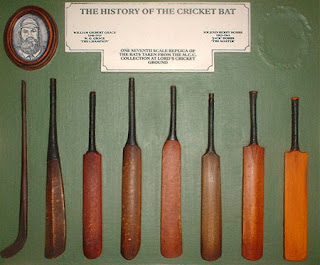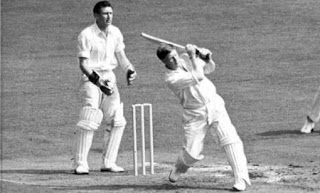Cricket has been played as a recognized sport since the early 18th century. The first recorded match was played in Sussex, England in 1697. In 1719, the first "county" match was played, with the Londoners (Middlesex) vs. the Kentish. It gained publicity in the southern counties of England, but was eventually transplanted to be mainly in the London grounds of wealthy patrons. During this time, crowds were often rowdy, with high monetary stakes on important matches.
The Hambledon Club, a small club in Hampshire, brought attention to the sport, as they challenged the larger clubs with a run for their money. Their historian, John Nyren, wrote prose literature on the subject of cricket. This team played its final recorded match in 1793 at Lord's in London, the most important cricket site in cricket history.
Lord's was begun in Dorset Square as a private cricket field by Thomas Lord, a Yorkshire man who bowled for the club. In 1813, the club was moved from its second location at St. John's Wood to its present field. However, the original Dorset Square turf was relaid with each change. The Marylebone Cricket Club, (MCC) with Lord's as its 'home base', is considered the international cricket authority.
In 1969, cricket administration underwent a dramatic change. The Cricket Council was formed at this point, including the M.C.C., the Test and County Cricket Board (TCCB), and the National Cricket Association. The MCC still holds responsibility for the laws, but it is no longer the sole governing body. The TCCB controls both the county matches and the international tests. Delegates from the Women's Cricket Association, umpires, Royal Air Force, Army, and Navy cricket are on the Council.
There is now no distinction between amateur and professional clubs. The county cricket matches are large attractions among all people in England. Also, the Oxford vs. Cambridge match is played as a major event every summer at Lord's. Cricket is truly England's national summer sport.
The Hambledon Club, a small club in Hampshire, brought attention to the sport, as they challenged the larger clubs with a run for their money. Their historian, John Nyren, wrote prose literature on the subject of cricket. This team played its final recorded match in 1793 at Lord's in London, the most important cricket site in cricket history.
Lord's was begun in Dorset Square as a private cricket field by Thomas Lord, a Yorkshire man who bowled for the club. In 1813, the club was moved from its second location at St. John's Wood to its present field. However, the original Dorset Square turf was relaid with each change. The Marylebone Cricket Club, (MCC) with Lord's as its 'home base', is considered the international cricket authority.
In 1969, cricket administration underwent a dramatic change. The Cricket Council was formed at this point, including the M.C.C., the Test and County Cricket Board (TCCB), and the National Cricket Association. The MCC still holds responsibility for the laws, but it is no longer the sole governing body. The TCCB controls both the county matches and the international tests. Delegates from the Women's Cricket Association, umpires, Royal Air Force, Army, and Navy cricket are on the Council.
There is now no distinction between amateur and professional clubs. The county cricket matches are large attractions among all people in England. Also, the Oxford vs. Cambridge match is played as a major event every summer at Lord's. Cricket is truly England's national summer sport.


No comments:
Post a Comment